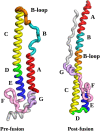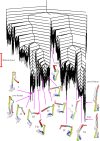Energy Landscape for the Membrane Fusion Pathway in Influenza A Hemagglutinin From Discrete Path Sampling
- PMID: 33102445
- PMCID: PMC7546250
- DOI: 10.3389/fchem.2020.575195
Energy Landscape for the Membrane Fusion Pathway in Influenza A Hemagglutinin From Discrete Path Sampling
Abstract
The conformational change associated with membrane fusion for Influenza A Hemagglutinin is investigated with a model based upon pre- and post-fusion structures of the HA2 component. We employ computational methods based on the potential energy landscape framework to obtain an initial path connecting these two end points, which provides the starting point for refinement of a kinetic transition network. Here we employ discrete path sampling, which provides access to the experimental time and length scales via geometry optimization techniques to identify local minima and the transition states that connect them. We then analyse the distinct phases of the predicted pathway in terms of structure and energetics, and compare with available experimental data and previous simulations. Our results provide the foundations for future work, which will address the effect of mutations, changes in pH, and incorporation of additional components, especially the HA1 chain and the fusion peptide.
Keywords: discrete path sampling; energy landscape; influenza; membrane fusion; rare event algorithms.
Copyright © 2020 Burke, Mantell, Pitt and Wales.
Figures




Similar articles
-
Intermonomer Interactions in Hemagglutinin Subunits HA1 and HA2 Affecting Hemagglutinin Stability and Influenza Virus Infectivity.J Virol. 2015 Oct;89(20):10602-11. doi: 10.1128/JVI.00939-15. Epub 2015 Aug 12. J Virol. 2015. PMID: 26269180 Free PMC article.
-
Energetics of the loop-to-helix transition leading to the coiled-coil structure of influenza virus hemagglutinin HA2 subunits.Proteins. 2009 Feb 1;74(2):291-303. doi: 10.1002/prot.22157. Proteins. 2009. PMID: 18618705
-
Exploring the early stages of the pH-induced conformational change of influenza hemagglutinin.Proteins. 2014 Oct;82(10):2412-28. doi: 10.1002/prot.24606. Epub 2014 Jun 9. Proteins. 2014. PMID: 24854389
-
Architecture of the influenza hemagglutinin membrane fusion site.Biochim Biophys Acta. 2003 Jul 11;1614(1):24-35. doi: 10.1016/s0005-2736(03)00160-3. Biochim Biophys Acta. 2003. PMID: 12873763 Review.
-
Early steps of the conformational change of influenza virus hemagglutinin to a fusion active state: stability and energetics of the hemagglutinin.Biochim Biophys Acta. 2003 Jul 11;1614(1):3-13. doi: 10.1016/s0005-2736(03)00158-5. Biochim Biophys Acta. 2003. PMID: 12873761 Review.
Cited by
-
pH-Dependent Mechanisms of Influenza Infection Mediated by Hemagglutinin.Front Mol Biosci. 2021 Dec 17;8:777095. doi: 10.3389/fmolb.2021.777095. eCollection 2021. Front Mol Biosci. 2021. PMID: 34977156 Free PMC article. Review.
-
Investigation into the effect of phenylalanine gating on anaerobic haem breakdown using the energy landscape approach.Protein Sci. 2025 Feb;34(2):e5243. doi: 10.1002/pro.5243. Protein Sci. 2025. PMID: 39873208 Free PMC article.
-
Novel Anti-Viral Properties of the Herbal Extract of Davallia mariesii against Influenza A Virus.Viruses. 2024 Mar 28;16(4):523. doi: 10.3390/v16040523. Viruses. 2024. PMID: 38675866 Free PMC article.
-
The Energy Landscape Perspective: Encoding Structure and Function for Biomolecules.Front Mol Biosci. 2022 Jan 27;9:820792. doi: 10.3389/fmolb.2022.820792. eCollection 2022. Front Mol Biosci. 2022. PMID: 35155579 Free PMC article.
-
Structural Transitions in Glassy Atactic Polystyrene Using Transition-State Theory.J Phys Chem B. 2021 Jul 8;125(26):7273-7289. doi: 10.1021/acs.jpcb.1c02618. Epub 2021 Jun 23. J Phys Chem B. 2021. PMID: 34161106 Free PMC article.
References
-
- Becker O. M., Karplus M. (1997). The topology of multidimensional potential energy surfaces: theory and application to peptide structure and kinetics. J. Chem. Phys. 106:1495 10.1063/1.473299 - DOI
-
- Broyden C. G. (1970). The convergence of a class of double-rank minimization algorithms 1. general considerations. J. Inst. Math. Appl. 6, 76–90. 10.1093/imamat/6.1.76 - DOI
Grants and funding
LinkOut - more resources
Full Text Sources
Research Materials
Miscellaneous

